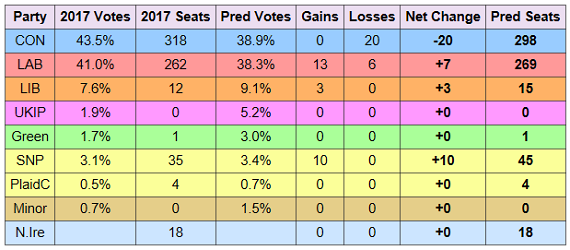Background: a new batch of Scottish polls
For this update on Scottish Westminster voting intentions and seat projections I will rely on the same three October polls I used for my Holyrood update. As a reminder they're here: Survation for the Sunday Post (fielded 28 September to 2 October), Panelbase for the Sunday Times (fielded 28 September to 4 October) and Survation for the SNP (fielded 3 to 5 October).
Here is what the three individual polls say and their weighted average. The result is slightly less good for the SNP than what we had in June-July but again better than the 2017 results.
Bear in mind all three polls were in the field between the Labour Conference and the SNP Conference. So they tell us nothing about a possible post-Conference bounce for the SNP but they tell a lot about the Magic Dick Effect for Labour. Which is a 2% swing from Labour to the SNP compared to the 2017 results. So much for Richard Leonard being the Next Scottish Wonder and Killing Off The Nats.
Then this only confirms the trend we have seen all along in 2018 polls: the SNP always the first party and Scottish Labour always unable to do really better than their 2017 performance. Surely some polls have been better for the SNP than what we have now. But being 2% up from 2017 is still better than being 2% down. Or isn't it, Richard?
So now might be a good time for the Scottish Branch Office of the English Labour Party to reassess their priorities for good. What does Scottish Labour actually stand for when bedding with the Tories in Scottish Councils? And shouldn't they tone down the 'SNP Bad' rhetoric when 31% of their own voters support Scottish Independence according to the last two Survation polls?
Turns out Scottish Labour have only themselves to blame for making themselves irrelevant. So now Scotland has turned into a Tory-SNP one-on-one. Which is exactly what the SNP should wish for.
But who's gonna be my MP now?
Here is what these three October polls would deliver. Seats by SLLM rating first and then the summary.
On this polling six seats would change hands. Five from Labour to the SNP and one from the Conservatives to the SNP. Again these results show that Conservative and LibDem MPs prove harder to unseat than Labour ones. But also that some of the projected SNP gains are quite fragile.
For the record here is the seat projection each 2018 poll would have delivered individually. Some far better for the SNP than current polling and some far worse. But in the end the big picture points to a SNP surge which was certainly not a done deal when facing all the recent anti-SNP propaganda.
Ending up six seats up from the last GE is obviously an excellent result for the SNP though we have seen better not too long ago. But as always the SNP need a fair assessment of which of their seats are actually in the danger zone and which opposition seats are ready to fall, and how this should dictate the allocation of resources and manpower in the next campaign.
So what could go wrong?
Right now 12 Scottish seats qualify as marginals. Noticeably down from the 2017 result when we had 20 such. And with only one sitting SNP MP in the danger zone but then he always was.
Oddly current polling being less favourable for the SNP than the June-July polls has also moved the frontier between marginals and safer seats deeper into Unionist territory. Seven Unionist seats are now endangered, including two LibDem seats that looked safe last time aboot. You never know what can happen in marginals.
After reallocating the marginals here are the possible ranges of seats current polling delivers for each party. Good again for the SNP as even the worst case scenario has them up from 2017. And as always nothing should be taken for granted, especially seats that might shift on some hundred votes.
And finally the full breakdown of seats, as usual from the worst to the best projected results for the SNP.
What to expect now?
Probably no more fresh Scottish polls for a long time, unless we finally get a late November snap GE. Which I don't think of as the most likely scenario right now. Then current good polling should not get the SNP into the false comfort of over-confidence. We all know how quickly a seemingly favourable situation might take a turn for the worse. So the SNP have to be ready for any upset and get prepared accordingly.
First and probably most important step is a massive GOTV effort by the SNP. Never forget that turnout dropped by 261k between 2015 and 2017 and there is every reason to believe these missing voters were massively SNP-leaning. If these voters had showed up the SNP would likely have cut their losses by half. And we also have repeatedly seen how differential turnout can hurt the SNP in Council by-elections, even in seats that on paper looked like a done deal.
Second point is to make sure the next GE campaign stays focused on the proper issues. It will not be about how the SNP do in Edinburgh but solely how Tories do in London. So let's not repeat 2017 and get cornered into discussing the Scottish Government's performance on devolved matters. The SNP has to be on the offensive on reserved matters, most prominently how their awful handling by the English Government also deeply hurts Scotland.
And as always stay tuned for further broadcasts.
Cha togar m' fhearg gun dìoladh
© Calum Macdonald, Rory Macdonald 1987











































